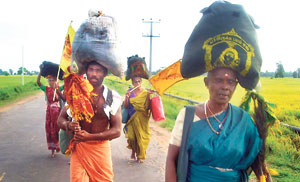There is a Sinhala saying about Kataragama-bound pilgrims that goes:
Dänagana giyot Kataragama,
Nodäna giyot ataramaga.
Translated, it means: “If you know the way, you come to Kataragama; if you don’t know the way, you get completely lost.”
Those familiar with Kataragama know it as a place of sacred power, governed by an ever youthful spirit that defies human comprehension. Most pilgrims attest to a baffling “unseen hand” of a higher power prevailing at the age-old jungle shrine, even behind a crassly commercial facade. Astute politicians have also taken note.
Recognising the shrine’s socio-political potential, some non-government organisations (NGOs) have jumped on the bandwagon by organising a mass march from Okanda to Kataragama, which they have styled a “pada yatra” or traditional pilgrimage on foot. The ostensible purpose of the march is to honour the tradition of the Kataragama Pada Yatra.
In recent years the Pada Yatra has declined in popularity. Indeed, it has almost disappeared, along with the veteran swamis who preserved Kataragama’s traditions, songs, legends and ancient wisdom – all now slowly vanishing.
 |
| Veteran foot pilgrims still practise the Pada Yatra, but they are few in number. They are being replaced by parties of imitators who only confuse the true pilgrims and obscure Kataragama’s ancient traditions. Photo taken this month outside Akkaraippattu by K. Vinayagamoorthy. |
As recently as the 1990s, there were still a few poets, minstrels, musicians, dancers, clowns, and ecstatics in pilgrim garb among the barefoot faithful. Some would appear to walk alone across the awe-inspiring landscape of eastern Sri Lanka.
The old swamis have either passed away or they no longer walk. Fewer and fewer pilgrims sing as they walk, fewer still go barefoot and hardly any have any inherited wisdom to share. Once upon a time villagers competed with each other to fete these swamis and swami ammas with food and hospitality.
The swamis of yore have been replaced by families with children in tow who trudge in silence, clad in sandals and wearing outlandish clothes they would not consider wearing at home. Villagers along the route may offer them dana, but once only, and then urge them to continue on their way. Most do not walk if they can avoid it but ride the full distance by bus or tractor up to Okanda, and even into the national park.
More recent developments are the Pada Yatra youth societies and the NGOs with their tractors, luxury vehicles, tents, electric generators and all the signs of wealth that traditional pilgrims shun. Society members and employees march single-file dressed in uniform-like attire, each wearing fashionable footgear or headwear.
These youths are fielded as “service volunteers” to serve the elderly but in reality they serve only themselves. During the day they rush ahead of the older pilgrims, leaving them to shoulder heavy burdens, and at night they listen, not to wisdom songs, but loud baila music sung to drums and radios.
What many pilgrims (including this writer) find most dismaying is the callous treatment given to tired foot pilgrims when they emerge from the jungle and face security checks.
The rag-tag poor and the elderly are ordered to wait in the scorching sun, while the uniformed members of well-heeled NGOs and other societies are courteously whisked through with minimal delay. In July 2007, I sat for hours with the poor pilgrims at the Varahana bridge.
The decline of the Pada Yatra did not occur overnight in a social vacuum, but in the context of a national decline affecting every village and town across the island, as reflected in the general scramble to grab land, possessions and power from neighbours and unborn generations.
Those great friends of Lanka’s authentic traditions, such as Rene Guenon and Ananda Coomaraswamy, warned that the forces of anti-tradition would advance a counterfeit tradition as a substitute for the real thing, before replacing it with an anti-tradition diametrically opposed to spirituality.
In terms of culture and religion, the process is deadly, as we see in the decline of the Kandyan dance, which has deteriorated from a mystical tradition to shallow entertainment and “dancing for dollars”.
The same process now threatens to subvert and destroy the island’s cultural and religious identity.
Sri Lankans should re-assess their ancestral traditions if they wish to recover their authentic identities, and they should do so fast.
The writer has walked the Kataragama Pada Yatra 20 times since 1972. A founding member of the Kataragama Devotees’ Trust, he has maintained the website www.kataragama.org since 1997.
|
